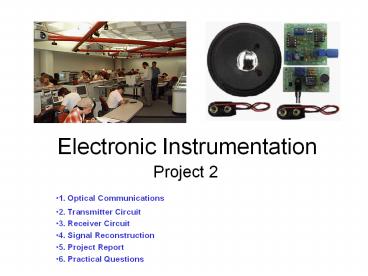Electronic Instrumentation - PowerPoint PPT Presentation
Title:
Electronic Instrumentation
Description:
Electronic Instrumentation ... and 48K Hz to reconstruct sound Input amplitude should not exceed 1V Receiver Circuit Receive Light Signal Inverting Amplifier ... – PowerPoint PPT presentation
Number of Views:224
Avg rating:3.0/5.0
Title: Electronic Instrumentation
1
Electronic Instrumentation
- Project 2
- 1. Optical Communications
- 2. Transmitter Circuit
- 3. Receiver Circuit
- 4. Signal Reconstruction
- 5. Project Report
- 6. Practical Questions
2
Optical Communications
3
Transmitting an audio signal using light
Transmitter Circuit
audio signal
Receiver Circuit
4
Modulation
- Modulation is a way to encode an electromagnetic
signal so that it can be transmitted and
received. - A carrier signal (constant) is changed by the
transmitter in some way based on the information
to be sent. - The receiver then recreates the signal by looking
at how the carrier was changed.
5
Amplitude Modulation
http//cnyack.homestead.com/files/modulation/modam
.htm
6
Frequency Modulation
http//cnyack.homestead.com/files/modulation/modfm
.htm
7
Pulse Width Modulation
http//cnyack.homestead.com/files/modulation/modpw
m.htm
8
Pulse Position Modulation
http//cnyack.homestead.com/files/modulation/modpp
m.htm
9
Optoisolators
- Optoisolators use light to transfer a signal
between two devices rather than a direct
electrical connection. - You can buy computer cards with optoisolating
connectors that protect the computer from devices
connected to it. Good for industrial
applications.
10
Servo-motor control
- The servo-motors are controlled by the computer
through an optoisolating card. - The low voltage DC computer is protected
(isolated) from the high voltage AC power needed
to turn the motors.
11
Transmitter Circuit
12
555-Timer in Astable Mode
13
Input and Modulated Output
14
Special Capacitors
DC Blocking Capacitor (High Pass Filter)
Bypass Capacitor (Low Pass Filter)
15
Sample Input and Output
- As input rises, pulses are longer
- As input falls, pulses are shorter
16
Your signal is what?
- Called pulse position modulation in .pdf file
- Also looks like pulse frequency and pulse width
modulation
17
Sampling Frequency
- The pot (used as a variable resistor) controls
your sampling frequency - Input frequency in audible range (0-4K Hz)
- Sampling frequency should be between 8KHz and 48K
Hz to reconstruct sound - Input amplitude should not exceed 1V
18
Receiver Circuit
19
Receive Light Signal
20
Inverting Amplifier (Pre-Amp)
21
Audio Amplifier
22
Audio Amplifier Details
increases gain 10X (optional)
386 audio amplifier
high pass filter
volume
low pass filter
23
Special Capacitors
DC Blocking Capacitor
Bypass Capacitor
24
Signal Reconstruction
- The signal is reconstructed well enough by this
design that it will be audible. - In order to improve the quality of the signal,
you will add an integrator, which will more
exactly reconstruct it. - Types of integrators
- passive integrator (low pass filter)
- active integrator (op amp integrator circuit)
25
Passive Integration
Integration works only at high frequencies w gtgt
wc. Unfortunately, your amplitude will
also decrease.
26
Active Integration
Integration does not work at frequencies below
wc. Your gain goes from -Rf/Ri to -1/RiC
27
Signal Reconstruction
- integration
- pulse on slope
- pulse off -- slope
- ratio determines rise and fall
- design parameters
- sampling frequency
- type of integrator
- integrator components
28
Comparing Output of Blocks
- location of points A-H are indicated in the
project write-up - function of each block you should be able to
determine from these notes and the experiments - take two measurements at a time
- A on channel 1 and B on channel 2
- B on channel 1 and C on channel 2
- take all measurements relative to ground
29
Project Report
- Introduction
- Application Goals
- Educational Goals
- Basic Design
- Identify function of each block
- Identify input frequency and amplitude
- Circuit diagram
- Circuit built and witnessed
- Take data at specified points
30
Final Design
- What type of integrator?
- What components?
- Calculations
- Circuit Diagram
- Testing Plan
- Design Changes
- Problems Encountered
- Take data at specified points
- Have changes improved audio quality?
31
Analysis and Comparison
- Analyze each block
- PSpice or hand analysis
- Show calculations or explain plot output
- Compare experimental with theoretical results
- How are they different?... the same?
- Why are they different?
- Compare basic and final design
- signal reconstruction
- sound quality
32
Personal Responsibilities
- Make a list of all tasks to be completed as part
of this project - Testing plan
- Keep everyone on task
- Assign responsibility for each task to one person
(tasks cannot be shared) - Have task assignment list checked out
33
Appendices
- Useful data or results from experiments
- Information resources
- From the web
- From the library or other sources
- Only attach useful information
- Useless information will result is a loss of
points - Explain the purpose of each piece of info
34
Practical Questions
- The participation points for this project will be
determined based on practical skills. To test
practical skills, students will be asked to
perform simple practical tasks related to this
project in a timely fashion. The instructor or
the TA will assign the points. - Please notice that the practical questions are
meant to be answered individually.
35
Sample Practical Questions
- set up scope to compare the output of two blocks
- set function generator to get a signal comparable
to an audio signal - capture the scope signal both as a picture and
data, using Agilent Intuilink - adjust sampling frequency
- choose integrator component values
- describe the goal and the methodology
- identify components and parts of each circuit
- debug the circuit
- connect the circuits to the power supply and to
the scope - use PSpice traces and cursors.
- draw Capture circuit































